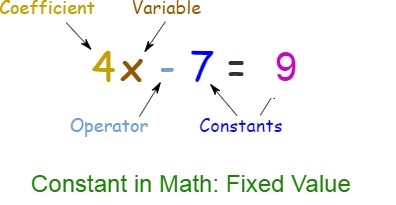Constants in Mathematics: Definition and Examples
A constant refers to a fixed value that does not change during a particular mathematical process or within a given context. It is a specific numerical or non-numerical value that remains the same throughout a mathematical expression, equation, or function. Constants are typically represented by letters, such as “a,” “b,” “c,” or “k,” and they are used to represent known and fixed quantities.
Categorization of Constants
Constants can be classified into different categories:
- Numeric Constants: These are fixed numerical values, such as 3, 5, π (pi), or √2 (square root of 2). Numeric constants can be integers, fractions, irrational numbers, or even complex numbers.
- Symbolic Constants: These are non-numeric constants represented by symbols or letters. They often appear in algebraic equations or formulas, such as “a,” “b,” or “c.” Symbolic constants are used to represent unknown or generic values that remain constant throughout the problem or calculation.
- Universal Constants: These are fundamental physical constants that have well-defined values and are used in scientific calculations. Examples include the speed of light in a vacuum (c), the gravitational constant (G), or the Planck’s constant (h).
- Mathematical Constants: These are special constants with specific mathematical significance. For instance, π (pi) represents the ratio of a circle’s circumference to its diameter, and e represents Euler’s number, a fundamental constant in exponential growth and logarithmic functions.
What is Constant in Math?
A quantity that has a fixed numerical value is called a constant in math. In an algebraic expression, a term that has no literal factors is called a constant term.
Constant Math Example

Another Example: in “x + 4 =6”, where 4 and 6 are called a constants.
Constants v/s Variables
| Constants | Variables | |
|---|---|---|
| Definition | Fixed values that do not change | Symbols or letters representing changing or unknown values |
| Representation | Specific numerical values or symbols | Symbols or letters |
| Role | Represent known and unchanging quantities | Represent unknown or changing quantities |
| Example | 3, 5, π (pi), √2 (square root of 2) | x, y, z |
| Stability | Remain the same throughout a calculation or context | Can vary depending on the problem or context |
| Purpose | Provide stability and known quantities | Allow for flexibility and solving for unknowns |
| Usage | Used to represent fixed values in equations or formulas | Used to denote changing or unknown values in equations or formulas |
Solved Examples
1. Example involving a constant: Equation: A = πr² In this equation, “A” represents the area of a circle, “π” (pi) is a constant representing the ratio of a circle’s circumference to its diameter, and “r” is the radius of the circle. Let’s say we have a circle with a radius of 5 units.
We can substitute the value of the radius into the equation to find the area:
A = π(5)² A = π(25) A ≈ 78.54 square units
Therefore, when the radius is 5 units, the area of the circle is approximately 78.54 square units.
2. Example involving a variable: Equation: 2x + 3 = 7 In this equation, “x” is a variable representing an unknown value. Our goal is to solve for “x.” We can do this by isolating the variable on one side of the equation.
Let’s solve the equation step by step:
2x + 3 = 7
=2x = 7 – 3
2x = 4
x = 4/2
x = 2
Therefore, the value of “x” that satisfies the equation is 2.
3. Example involving both constants and variables: Equation: V = s²h In this equation, “V” represents the volume of a rectangular prism, “s” is the length of the side, and “h” is the height of the prism. Let’s consider a scenario where the side length is 6 units and the height is 10 units.
We can substitute these values into the equation to find the volume:
V = (6)²(10)
= 36(10)
V = 360 cubic units
Therefore, when the side length is 6 units and the height is 10 units, the volume of the rectangular prism is 360 cubic units.
FAQs on Constant
What is the definition of a constant in mathematics?
In mathematics, a constant refers to a fixed value that does not change during a specific mathematical process or within a given context. It is a specific numerical or non-numerical value that remains the same throughout a mathematical expression, equation, or function.
What is the difference between a constant and a variable?
Constants are fixed values that remain unchanged, while variables are symbols or letters used to represent unknown or changing values. Constants provide stability and represent known quantities, while variables allow for flexibility and solving for unknowns.
Can a constant value be changed during calculations?
No, by definition, constants are fixed values that do not change during calculations. They maintain their value throughout a mathematical process or within a specific context.
How are constants represented in mathematical equations?
Constants are typically represented by specific numerical values or symbols. Numeric constants can be expressed as specific numbers, such as 3, 5, or π (pi), while symbolic constants are represented by letters or symbols, such as “a,” “b,” or “c.”
What are some examples of mathematical constants?
Some examples of mathematical constants include π (pi), which represents the ratio of a circle’s circumference to its diameter, and e (Euler’s number), a fundamental constant in exponential growth and logarithmic functions. Other constants include the square root of 2 (√2) and various universal constants like the speed of light (c) and the gravitational constant (G).
